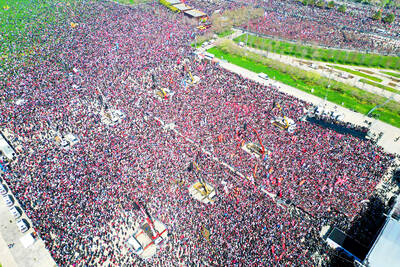If climbing a stairway to heaven sounds like too much hard work, then a conference of 70 scientists and engineers opening in Santa Fe, New Mexico, yesterday may offer hope of a more leisurely way into space.
In two days of discussions, the scientists aim to turn into a reality an ambition that has been around for at least a century: the creation of a space elevator that would deliver satellites, spacecraft and even people thousands of kilometers into space along a vertical track.
Engineers say that recent advances in materials science -- particularly in the development of carbon nanotubes -- mean that such a system, which first gained widespread attention when the science fiction writer Arthur C Clarke described it in his 1979 novel Fountains of Paradise, is no longer pure science fiction.
Clarke -- who once said a space elevator would only be built "about 50 years after everyone stops laughing" -- was due to address the scientists at the Santa Fe conference yesterday by satellite link from his home in Sri Lanka.
The American space agency NASA is no longer laughing. It is putting several million US dollars into the project under its advanced concepts program.
At the heart of a space elevator would be a cable reaching up as far as 100,000km from the surface of the Earth. The earthbound end would be tethered to a base station, probably somewhere in the middle of the Pacific ocean. The other end would be attached to an orbiting object in space acting as a counterweight, the momentum of which would keep the cable taut and allow vehicles to climb up and down it.
A space elevator would make rockets redundant by granting cheaper access to space. At about a third of the way along the cable -- 36,000km from Earth -- objects take a year to complete a full orbit.
If the cable's center of gravity remained at this height, the cable would remain vertical, as satellites placed at this height are geostationary, effectively hovering over the same spot on the ground.
To build a space elevator, such a geostationary satellite would be placed into orbit carrying the coiled-up cable.
One weighted end of the cable would then be dropped back towards Earth, while the other would be unreeled off into space.
Mechanical lifters could then climb up the cable from the ground, ferrying up satellites, space probes and eventually tourists.
No scientist has yet succeeded in making a material, which many expect will be made out of carbon nanotubes, strong but light enough to make the cable, but Rodney Andrews, a carbon nanotube expert from the University of Kentucky will tell the conference: "Until some of the basic science concerning how to connect nanotubes together and transfer load between them in a composite is understood it will remain elusive, but a lot of progress is being made."

A fire caused by a burst gas pipe yesterday spread to several homes and sent a fireball soaring into the sky outside Malaysia’s largest city, injuring more than 100 people. The towering inferno near a gas station in Putra Heights outside Kuala Lumpur was visible for kilometers and lasted for several hours. It happened during a public holiday as Muslims, who are the majority in Malaysia, celebrate the second day of Eid al-Fitr. National oil company Petronas said the fire started at one of its gas pipelines at 8:10am and the affected pipeline was later isolated. Disaster management officials said shutting the

UNREST: The authorities in Turkey arrested 13 Turkish journalists in five days, deported a BBC correspondent and on Thursday arrested a reporter from Sweden Waving flags and chanting slogans, many hundreds of thousands of anti-government demonstrators on Saturday rallied in Istanbul, Turkey, in defence of democracy after the arrest of Istanbul Mayor Ekrem Imamoglu which sparked Turkey’s worst street unrest in more than a decade. Under a cloudless blue sky, vast crowds gathered in Maltepe on the Asian side of Turkey’s biggest city on the eve of the Eid al-Fitr celebration which started yesterday, marking the end of Ramadan. Ozgur Ozel, chairman of the main opposition Republican People’s Party (CHP), which organized the rally, said there were 2.2 million people in the crowd, but

The US government has banned US government personnel in China, as well as family members and contractors with security clearances, from any romantic or sexual relationships with Chinese citizens, The Associated Press (AP) has learned. Four people with direct knowledge of the matter told the AP about the policy, which was put into effect by departing US ambassador Nicholas Burns in January shortly before he left China. The people would speak only on condition of anonymity to discuss details of a confidential directive. Although some US agencies already had strict rules on such relationships, a blanket “nonfraternization” policy, as it is known, has

OPTIONS: Asked if one potential avenue to a third term was having J.D. Vance run for the top job and then pass the baton to him, Trump said: ‘That’s one,’ among others US President Donald Trump on Sunday that “I’m not joking” about trying to serve a third term, the clearest indication he is considering ways to breach a constitutional barrier against continuing to lead the country after his second term ends at the beginning of 2029. “There are methods which you could do it,” Trump said in a telephone interview with NBC News from Mar-a-Lago, his private club. He elaborated later to reporters on Air Force One from Florida to Washington that “I have had more people ask me to have a third term, which in a way is a fourth term